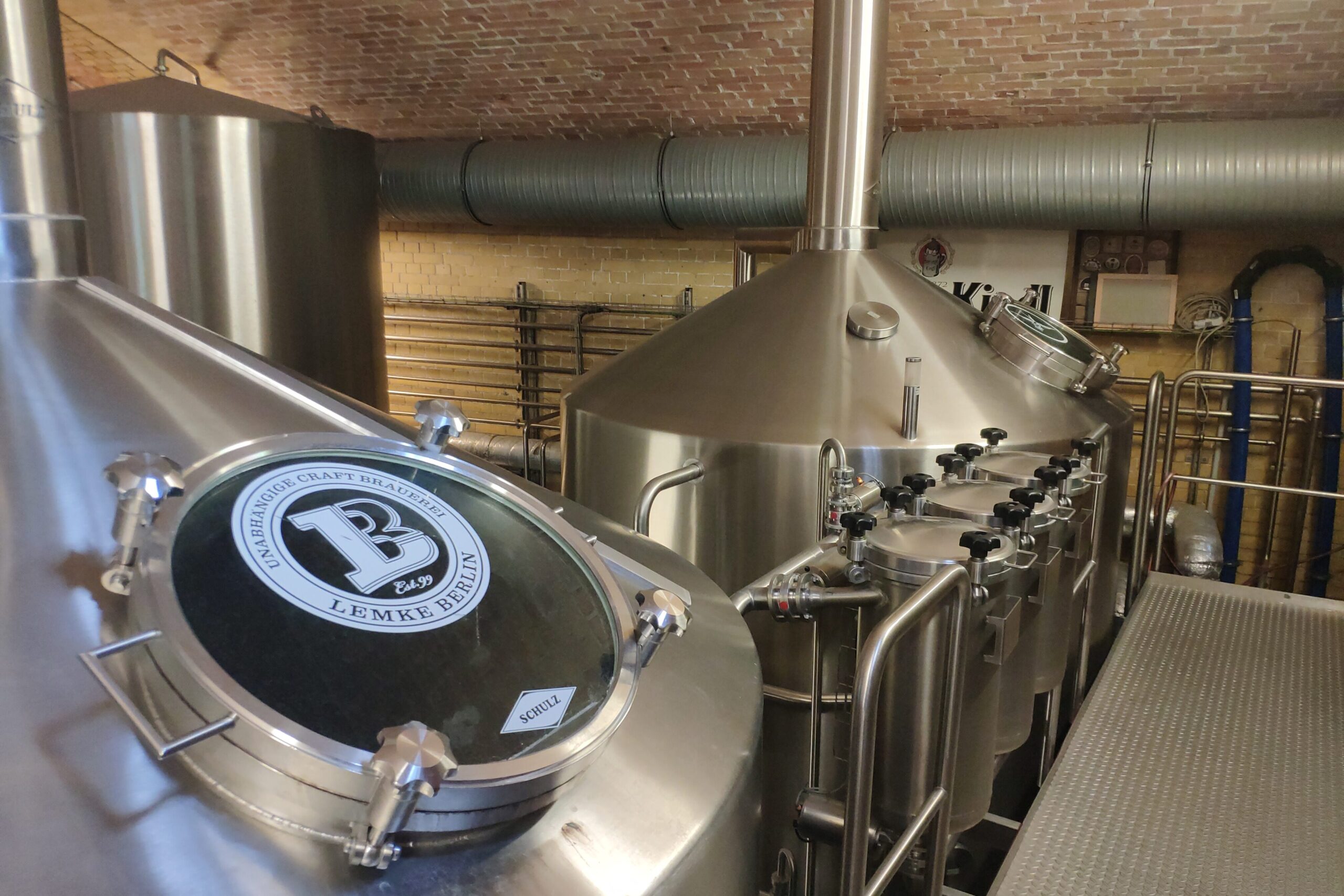Berlin is a city renowned for its vibrant culture and rich history, but has also become a hub for craft beer enthusiasts. As a homebrewer, my passion for beer makes me want to learn the stories and craft behind each brew. So in 2025, I decided to go on a mission: Experience every brewery tour that Berlin has to offer to find out which one is the best. Spoiler: “best” depends on what you are looking for. I want to share my personal impression from these tours and giving you a recommendation, so hopefully this guide will help you to find the perfect Berlin brewery tour that matches your individual taste and interest.
Berliner Berg
Best for: Trying a wide range of different beer styles
When: Friday, Saturday
Language: German
Duration: 1.5 hours
Price: 19 EUR per person → Book here
Located in an industrial area near Treptower Park, the Berliner Berg brewery is a 15 min. walk from either the Treptower Park or Sonnenallee S-Bahn stations of the Ringbahn. Led by a knowledgeable brewing technology student, you explore the production facility of Berliner Berg, which was opened in 2021 in this location. Expect an informative journey through the modern 3000L brewhouse, proving you a comprehensive understanding of the different steps involved in brewing. It should be noted that bottling occurs off-site, so only the brewing production and lagering tanks can be seen on the tour.
The highlight of the tour is the beer tasting session held in the beer garden next to the facility. Visitors have the opportunity to try a diverse set of 5 different beers, ranging from classic lagers to various styles of ales, and the brewery’s very own Berliner Weisse. The selection of beers may vary, depending on what’s on tap at the time of your visit. After the tour guests are invited to stay in the beer garden, where a food stand offers a selection of smaller snacks, while you’re working yourself through the list of available beers.
Brewdog Dogtap Berlin
Best for: Spending an afternoon as a family / Seeing a state-of-the-art brewing facility
When: Saturday, Sunday
Language: German (late afternoon) or English (early afternoon)
Duration: 1.5 hours
Price: 15 EUR per person (paid on-site) → Book here
The Brewdog Dogtap is located in an industrial park in Mariendorf, outside the core of Berlin. The location requires a bit of travel, you should expect up to an hour. It can be reached via U6 Alt-Mariendorf and a subsequent 20 mins. walk, or look for Bus 181. Though it’s actually best to be reached by car. The brewery is housed within the historic walls of former gasworks, which was initially transformed by the US-based Stone Brewery, then taken over in 2019 by the Scottish Brewdog brewery to become their flagship on the European mainland.
The tour was lead by a knowledgeable brewing technology student who was giving the most sophisticated explanations on the brewing process and the equipment of all my tours. It is also Berlin’s largest brewhouse that can be visited on a tour, featuring a state-of-the-art 10,000L brewing system and impressive lagering tanks of 30,000L capacity that almost scratch the roof. There is also a 1000L pilot brewery, which cannot be visited, but seen through glass windows. Guests get to taste 3 beers from the Brewdog selection, with the bar offering additional options like sours, ciders and non-alcoholics. The place has a restaurant with a great menu, but what makes this place distinct are the entertainment options in the hall, including shuffleboard and bowling, make it an ideal spot for an afternoon visit with the family. Note that children cannot join the tour, though the atmosphere is generally very family-friendly.
BRLO Brwhouse
Best for: Combining the tour with a visit in a beautiful beer garden
When: Thursday, Friday, Saturday, Sunday
Language: German (not Friday), English
Duration: 1.5 hours
Price: 19 EUR per person → Book here
The BRLO Brwhouse (yes, that’s how it’s officially spelled) is conveniently located next to the Gleisdreieck Park in the city center and accessible via the U1/U2/U3 lines to the Gleisdreieck station. The Brwhouse, built from old shipping containers as a temporary structure, was once the main production facility of the BRLO brewery. Nowadays the site is no longer operational – production has shifted to a new site in Spandau – so the tour provides an curious look at the former brewing system and the lagering tanks, which continue to serve the on-site restaurant and beer garden.
Led by an enthusiastic and very knowledgeable guide, the tour delivers an comprehensive and engaging introduction to beer, covering not just the brewing process but also the historical and cultural significance of the beverage. Included in the tour is the tasting of 5 different beers from the wide range of BRLO beers. After the tour, visitors can stay in the family-friendly beer garden (or restaurant), which offers a variety of food options and drinks, including the range of BRLO beers as well as other national and international breweries.
Fuerst Wiacek
Best for: If you love NEIPA-style beers / Seeing a state-of-the-art brewing facility
When: Friday
Language: English
Duration: 1 hour
Price: 15 EUR per person → Book here

The Fuerst Wiacek brewery, located in Siemensstadt to the west of Berlin, offers a glimpse into one of the city’s most innovative brewing operations. Reachable via the U7 Siemensdamm station, the journey might take up to an hour depending on your starting point. My tour was led by the co-founder Georg (your experience might vary), who was keen on telling us the fascinating evolution of the brewery, from its origins as a gypsy brewers to establishing their own modern production facility in 2021. This modern industrial hall with its 5000L fully automated brewhouse and a state-of-the-art canning line serves as the backdrop to their narrative of perseverance and innovation.
Included in the tour is one beer, enjoyed either before or after the tour. On the day of the tour, the brewery has its regular “Späti Fridays” when the adjacent tap room is opens guests. Here you have the opportunity to try brand new batches directly from tap or pick a canned beer from the fridges, including the renowned NEIPA-style brews that Fuerst Wiacek is to well known for. With seating both indoors and outside at beer tables, the atmosphere is very casual and relaxed, providing opportunities to engage with the founders and employees of the facility, as well as other beer enthusiasts who found their way to Siemensstadt.
Heidenpeters
Best for: Seeing the most unique brewing system in Berlin
When: Friday once a month
Language: German
Duration: 1 hour
Price: 25 EUR per person → Book here
The Heidenpeters brewery within the popular Markthalle Neun is best reached via the U1/U3 U-Bahn lines to Görlitzer Bahnhof. The tour begins at the bar in the Markthalle, where you’re greeted with the first beer, which you can choose from the beers available on tap. The tour offers a distinct and personal glimpse into Berlin’s craft beer scene, as it is led by the founder Johannes Heidenpeter himself. It takes visitors into the basement of the Markthalle, revealing stories about his brewing journey and the establishment of this very unique production facility. The brewery operates an unconventional 1000L custom-built brewing system, affectionately called a “Frankenstein system” for its quirks and character, which the brewery team has learned to tame over the years.
The tour’s highlight is definitely the visit in the tank room, where you will enjoy a beer drawn fresh from the horizontal lagering tanks. The tour finishes with a look at the compact bottling line, which is cramped into a tiny room on the side. After the guided experience, participants are invited back to the bar for another beer from tap, which is featuring Heidenpeters core beers, seasonal ones, and special brews. Although the Markthalle closes at 8 PM, there’s still time to enjoy the company of the friendly owner, who mingles with guests, sharing more stories and beers. Once the stands close, it’s a perfect opportunity to head off to enjoy the lively bar scene in the area.
Lemke Berlin
Best for: Visiting the most unique location for a brewery in Berlin / Trying a wide range of different beer styles
When: Thursday, Saturday, Sunday
Language: German or English (Saturday)
Length: 2 hours
Price: 26.26 EUR per person → Book here

The Lemke brewery is located in the heart of Berlin between Hackescher Markt and Alexanderplatz. Easily accessible from either station, the meeting point for this tour is the “barrel room” under one of the S-Bahn arches. Enter either through the brewery main gate or from the other side through Das Lemke restaurant near Hackescher Markt. This facility stands out for its distinctive setup, as the modern brewhouse was built into the arches of the Stadtbahn in 2018, now housing a 3500L brewing system, along with tanks, bottling, canning, and pasteurization lines.
Guided by a knowledgeable brewing science student (you might recognize a pattern) with firsthand experience working at the brewery, the tour delivers detailed insights into every step of the brewing process. The guide’s ability to answer even complex questions about machinery and process caters to both novice and seasoned beer enthusiasts like myself. Visitors are served six beers from the range of Lemke brews. One is served at the start, followed by five very different beers after the brewhouse tour, including the renowned Berliner Weisse and Lemke’s Original (a dark lager). After the tour, guests are encouraged to enjoy food and more drinks at the restaurant locations Das Lekme at Hackescher Markt or the Braumeisterei at Alexanderplatz. The first gives you the chance to admire the original copper brewing system that Lemke started with in 1999.
Vagabund Brewery
When: Thursday, Saturday
Language: English
Duration: 2 hours
Price: 23.11 EUR per person → Book here
Coming soon
Located in the north of Berlin in Wedding. Built in a hundred year old former boiler house. 4500L brewhouse. 1 starter, 5 beers from the tap room (16 available, not only from Vagabund).


